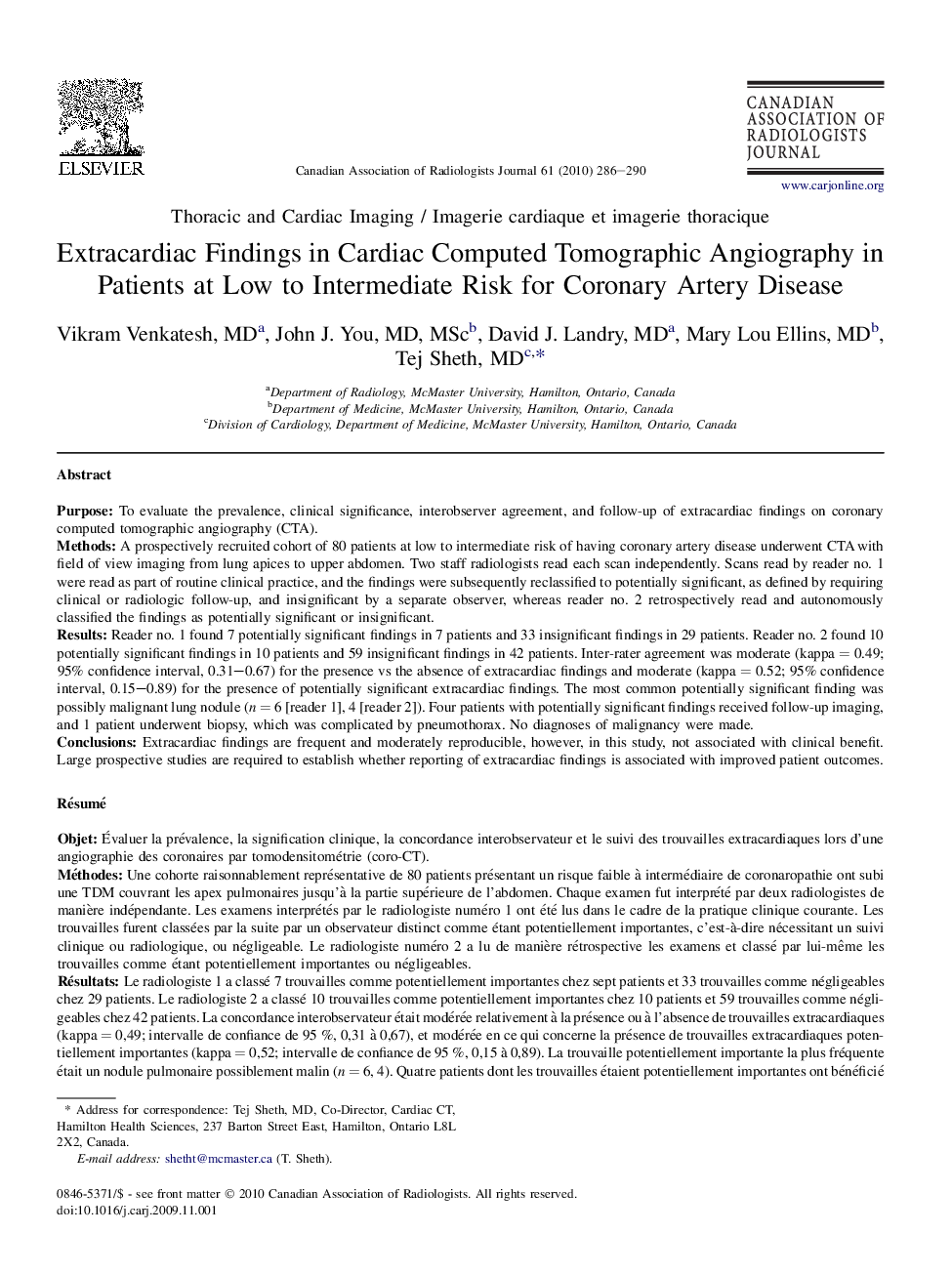| Article ID | Journal | Published Year | Pages | File Type |
|---|---|---|---|---|
| 4220701 | Canadian Association of Radiologists Journal | 2010 | 5 Pages |
PurposeTo evaluate the prevalence, clinical significance, interobserver agreement, and follow-up of extracardiac findings on coronary computed tomographic angiography (CTA).MethodsA prospectively recruited cohort of 80 patients at low to intermediate risk of having coronary artery disease underwent CTA with field of view imaging from lung apices to upper abdomen. Two staff radiologists read each scan independently. Scans read by reader no. 1 were read as part of routine clinical practice, and the findings were subsequently reclassified to potentially significant, as defined by requiring clinical or radiologic follow-up, and insignificant by a separate observer, whereas reader no. 2 retrospectively read and autonomously classified the findings as potentially significant or insignificant.ResultsReader no. 1 found 7 potentially significant findings in 7 patients and 33 insignificant findings in 29 patients. Reader no. 2 found 10 potentially significant findings in 10 patients and 59 insignificant findings in 42 patients. Inter-rater agreement was moderate (kappa = 0.49; 95% confidence interval, 0.31–0.67) for the presence vs the absence of extracardiac findings and moderate (kappa = 0.52; 95% confidence interval, 0.15–0.89) for the presence of potentially significant extracardiac findings. The most common potentially significant finding was possibly malignant lung nodule (n = 6 [reader 1], 4 [reader 2]). Four patients with potentially significant findings received follow-up imaging, and 1 patient underwent biopsy, which was complicated by pneumothorax. No diagnoses of malignancy were made.ConclusionsExtracardiac findings are frequent and moderately reproducible, however, in this study, not associated with clinical benefit. Large prospective studies are required to establish whether reporting of extracardiac findings is associated with improved patient outcomes.
RésuméObjetÉvaluer la prévalence, la signification clinique, la concordance interobservateur et le suivi des trouvailles extracardiaques lors d'une angiographie des coronaires par tomodensitométrie (coro-CT).MéthodesUne cohorte raisonnablement représentative de 80 patients présentant un risque faible à intermédiaire de coronaropathie ont subi une TDM couvrant les apex pulmonaires jusqu'à la partie supérieure de l'abdomen. Chaque examen fut interprété par deux radiologistes de manière indépendante. Les examens interprétés par le radiologiste numéro 1 ont été lus dans le cadre de la pratique clinique courante. Les trouvailles furent classées par la suite par un observateur distinct comme étant potentiellement importantes, c'est-à-dire nécessitant un suivi clinique ou radiologique, ou négligeable. Le radiologiste numéro 2 a lu de manière rétrospective les examens et classé par lui-même les trouvailles comme étant potentiellement importantes ou négligeables.RésultatsLe radiologiste 1 a classé 7 trouvailles comme potentiellement importantes chez sept patients et 33 trouvailles comme négligeables chez 29 patients. Le radiologiste 2 a classé 10 trouvailles comme potentiellement importantes chez 10 patients et 59 trouvailles comme négligeables chez 42 patients. La concordance interobservateur était modérée relativement à la présence ou à l'absence de trouvailles extracardiaques (kappa = 0,49; intervalle de confiance de 95 %, 0,31 à 0,67), et modérée en ce qui concerne la présence de trouvailles extracardiaques potentiellement importantes (kappa = 0,52; intervalle de confiance de 95 %, 0,15 à 0,89). La trouvaille potentiellement importante la plus fréquente était un nodule pulmonaire possiblement malin (n = 6, 4). Quatre patients dont les trouvailles étaient potentiellement importantes ont bénéficié d'un examen de suivi, et un patient a subi une biopsie, qui a été compliquée par un pneumothorax. Aucun diagnostic de malignité n'a été fait.ConclusionsLes trouvailles extracardiaques sont fréquentes et modérément reproductibles; cependant, dans cette étude, elles ne sont pas associées à des avantages cliniques. Des études prospectives d'envergure sont nécessaires afin d'établir si la description des trouvailles extracardiaques est bénéfique pour les patients.
